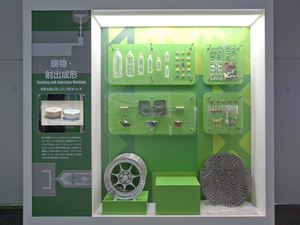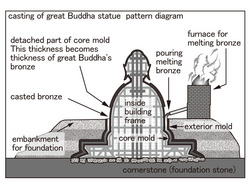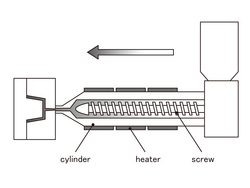Nagoya City Science Museum
TOP > Exhibition Guide > Keyword Search > Starting with "M" > mass production > Casting and Injection Molding
Casting and Injection Molding

Purpose of Exhibition
When making parts from metal or plastic, one way to do this is by casting and injection molding. Casting is a method in which melted metal with a high temperature is poured into a mold, while injection molding is a method in which plastic is melted, pressured, and poured into a mold. The purpose of this exhibition is to deepen your understanding of the two processing methods.


Additional Knowledge
[Great Buddha of Todaiji Temple]
Casting has been going on for a long time. The great Buddha of Todaiji Temple in Nara was also made by casting.
The statue was erected in 743 (in the 15th year of Tempyo) by the Emperor Shomu, due to an "imperial edict". The great Buddha was completed in 771 (in the 2nd year of Houki), 30 years after the "imperial edict" was issued.
The Todaiji Temple record stipulates the number of manual laborers involved in the construction of the hall and the Buddha reached a total of 2,180,000 people. The Emperor Shomu passed away during the construction.
The following is how to cast the great Buddha.
First, clay is applied all over the structure of the Buddha statue, then clay from the structure is detached and split into several sections. While baking the detached clay parts in an oven, which become a mold after assembling, the surface of the clay structure is shaved down about 5cm. This surface trimming will create a 5-cm gap between the mold and the structure, into which melted bronze will be poured. Since it is a big statue, the bronze pouring was carried out 8 times from the bottom.
To melt bronze, many melting furnaces (koshiki) were lined up side by side, sending air by stepping on windbag (tatara), and the melted bronze was poured a mold all together (Figure 1).
[Industrial Revolution and Iron]
Due to the industrial revolution that started in England in the 18th century, a large amount of iron was made. Bridges, ships, artillery, and many more items were produced by casting.
The British Iron Bridge, completed in 1779, is known as the world's first bridge made entirely of cast iron, and is designated also as a world heritage site.
[Car Engine]
Car engines are also made by casting. The engine mentioned here indicates a cylinder block with a piston moving fast in a hollow. It must be created wisely so that melted iron does not enter the hollow.
To make the hollow, a sand core (nakago), which has been hardened with oil, is used. Random experiments had been repeated many times to find out which oil and sand would be suitable, and subsequently the answer was discovered after many failures.
[Injection Molding]
A similar technology to casting, injection molding is also used to process plastic materials. Almost all plastic products are processed with this technology.
Plastic has two different types. One is thermosetting and the other is thermoplastic. The former indicates the property, or the portion of the plastic, which becomes soft when heated, and the latter is hardened when heated. Although both thermoplastic and thermosetting plastic can be injected and molded, the methods differ.
In thermoplastic injection molding, plastic is heated, dissolved, and hardened in a mold heated on low heat (Figure 2). Plastic in general is heated with a higher temperature than the melting point of plastic or glass-transition temperature (50 to 150 degree celsius) and its viscosity is lowered. Since thermoplastic, however, starts oxidative decomposition at about 200 degree celsius, plastic cannot be heated over a high temperature in thermoplastic injection molding. Injection moldings of thermoplastics are not used for hot plastics. In a short time, a mold must be filled up with high pressure.
When thermosetting plastic is injected and molded, it needs to be heated to about 50 degrees celsius. After it has melted soft, it requires to be filled in a mold heated with a high temperature (about 150 degree celsius) and solidified. Due to the low viscosity of thermosetting plastic when liquefied with a high temperature, it does not require such a high pressure as for when filling up a mold. For this reason, thermosetting plastic is used for a sealing device covering outside of a semiconductor. On the other hand, since it takes a long time to be solidified, it has a low efficiency.
Injection molding seems similar to casting using a mold. But in casting, metal surpasses its melting point and is poured into a mold with low pressure in a state of liquid with low viscosity, whereas injection molding is characterized by the need for high pressure and relatively low temperature (180 to 450 degree celsius). They are indispensable manufacturing techniques for mass production.
Cooperation:
Nagoya City Technical High School
Nagoya City waterworks and Sewerage Bureau
Article by Koichi Mabuchi, curator
